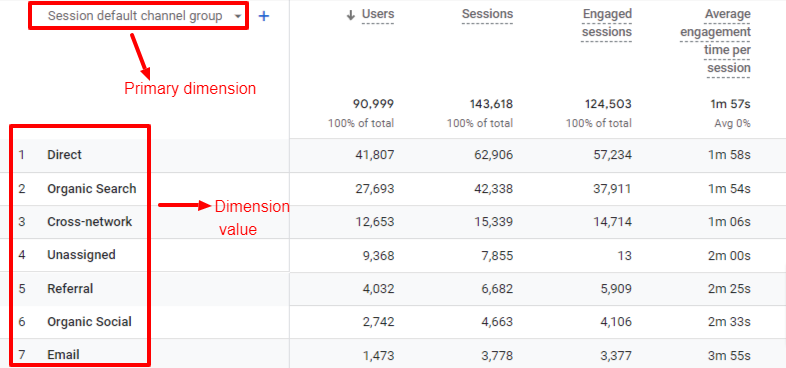The Value of Secondary Dimension in Google Analytics for Your SEO
The Value of Secondary Dimension in Google Analytics for Your SEO
Blog Article
Transform Your Analytics Strategy With Additional Measurement in Google Analytics
By integrating secondary measurements into information analysis, a brand-new layer of insights arises, dropping light on elaborate customer habits and communications. The calculated application of secondary measurements holds the key to opening a treasure chest of important information that can reinvent how organizations act and interpret upon their information.
Comprehending Second Measurements in Google Analytics
Secondary dimensions in Google Analytics give extra context to key data by enabling customers to evaluate metrics across a 2nd measurement, offering deeper understandings into user habits and communications on a web site. Secondary Dimension in Google Analytics. While primary measurements supply basic information factors such as pageviews, bounce rate, and session duration, additional measurements offer an even more comprehensive view by segmenting the primary data better. This segmentation enables customers to analyze metrics in combination with an additional dimension, such as web traffic sources, demographics, or individual behavior
Benefits of Making Use Of Secondary Dimensions
Utilizing secondary dimensions in Google Analytics uses a tactical benefit by boosting the deepness of evaluation and giving a more extensive understanding of user interactions and actions on a website. By incorporating secondary dimensions, analysts can gain valuable insights into the performance of details sectors or variables within their information. This makes it possible for a much more in-depth assessment of customer actions past surface-level metrics, permitting for a much deeper expedition of the aspects influencing individual engagement and conversions.

Exactly How to Execute Secondary Measurements
When integrating additional dimensions in Google Analytics, one important action is to pick the relevant metrics and measurements to improve the evaluation process. Clicking on this button will certainly open up a drop-down food selection listing various dimensions that can be included to your key measurement for deeper insights.
After choosing the ideal secondary measurement, such as 'Source/Medium' or 'Device Group,' Google Analytics will display the data in a much more thorough layout, allowing you to cross-analyze different elements of customer actions. Remember to explore various mixes of secondary and primary dimensions to discover useful patterns and patterns that can notify your advertising and marketing strategies. By implementing secondary dimensions thoughtfully, you can gain a much more detailed understanding of your internet site or app performance and make data-driven decisions to optimize your digital presence.
Studying Information With Second Measurements
Enhance your information analysis in Google Analytics by incorporating secondary measurements to dig deeper right into user behavior patterns and optimize your electronic advertising techniques efficiently - Secondary Dimension in Google Analytics. By adding second dimensions to your primary information, you can get important insights click for info that can aid you make notified decisions regarding your site or app performance
Evaluating information with additional dimensions permits you to section your primary information even more, providing an extra detailed view of customer interactions. As an example, incorporating the primary dimension of 'source/medium' with a second measurement like 'landing web page' can expose which specific pages are driving website traffic from different resources. This details can be critical in refining your content method or optimizing your marketing campaign to enhance conversions.
In addition, utilizing additional measurements enables you to determine correlations between different metrics, aiding you recognize the impact of different aspects on customer actions. Whether it's assessing demographics alongside user interaction metrics or tool groups with conversion prices, secondary dimensions equip you to discover concealed fads and patterns that can guide your marketing efforts.
Enhancing Performance With Secondary Measurements
To enhance the efficiency of information analysis and decision-making in Google Analytics, incorporating second dimensions is essential to maximizing performance metrics and obtaining much deeper understandings right into customer actions patterns. By making use of second dimensions, experts can dig beyond surface-level data and discover important connections that might otherwise go unnoticed. This optimization technique enables companies to customize their advertising and marketing initiatives a lot more properly, determine areas for enhancement in website usability, and enhance total customer experience.
Secondary dimensions offer an even more thorough sight of individual interactions by offering additional context to primary information metrics. For instance, matching the main dimension have a peek at these guys of 'touchdown web page' with an additional dimension like 'tool classification' can reveal whether certain tools are more probable to drive engagement on specific touchdown web pages. This insight can educate responsive design renovations or targeted marketing methods to increase performance.

Verdict
Finally, the integration of secondary measurements in Google Analytics offers services with an effective device to enhance their analytics approach. Secondary Dimension in Google Analytics. By delving deeper into individual behavior and communications, marketing experts can discover valuable understandings that can drive performance optimization and improve the general customer experience. Leveraging second dimensions permits an extra detailed analysis of information, causing even more informed decision-making and tailored advertising and marketing initiatives
Secondary dimensions in Google Analytics supply click here for more additional context to primary information by enabling individuals to examine metrics across a second measurement, supplying deeper understandings into user habits and communications on an internet site. While primary measurements supply basic data points such as pageviews, bounce price, and session duration, secondary measurements offer a more in-depth view by segmenting the key information better.One of the crucial advantages of using secondary dimensions is the ability to uncover connections and patterns that might not be promptly apparent when evaluating data with main measurements alone.When integrating second measurements in Google Analytics, one crucial step is to choose the pertinent metrics and dimensions to improve the evaluation process. Coupling the primary measurement of 'touchdown page' with a secondary measurement like 'device classification' can reveal whether certain tools are much more likely to drive involvement on specific touchdown web pages.
Report this page